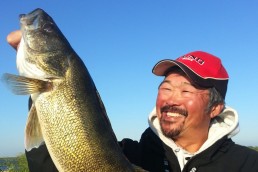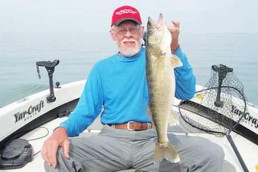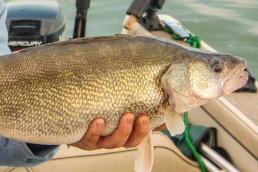Wood and Weeds are for Walleyes
SHARE THIS POST
Don’t allow the walleyes to give you the slip, especially when weeds are up or you’re fishing heavy-duty timber.
Walleyes love wood and weeds, and slip bobbers are extremely effective, especially with spinners or ’crawler harnesses. Slip bobbers can be effective from Memorial Day through June, and all the way to the end of summer. And remember, spinners tipped with nightcrawlers are an excellent tactic as well. But the key is using the right rig in the right place at the right time.
For slip bobbers, start by spooling up 10-pound-test superbraid on a spinning reel matched with a 7-foot 6-inch rod. The extra-length rod helps take up slack during a hook-set. The superbraid is for your main line and helps you from losing your bobber.
Good, high-quality thread-style bobber stops work best, as they are highly visible and can be reset for depth time and time again. Just leave tag ends of about an inch long, so when you do move the knot it’s easy to retighten. Next, add a slip bobber like Venom’s adjustable foam float and then add a barrel swivel. From the swivel, tie on a 2-foot leader of 8-pound-test fluorocarbon line. That way, if you get snagged and it breaks off you only lose what’s below the swivel instead of losing the entire rig, float and all. Also, tie on a plain hook or a small 1/16-ounce jig, and experiment with style and color.
Add enough weight to balance the float. Or, if you are using a Venom, you can adjust with minimal weight below, add a leech, and you’re all set. And remember, small split shot will often do the trick.
Concentrate your search for fish in shallow wood or weeds, just 3 to 5 feet deep, early in the summer. Most years, you’ll have to move deeper to the 12- to 14-foot range by late July and early August. That transition time can vary depending upon the rain, water level and warm or cold temperatures.
Trees with branches that spread out rather than ones that are straight up and down are typically best. Bigger fish are usually in the thickest trees too, so the heavier the concentration of trees the better. Eliminate unproductive areas by looking for points and inside turns in the tree line. And if you can see the trees, tie both the front and rear of the boat to the wood, if you can. This eliminates lost anchors as well as needless boat movement that cause bobbers to drift, causing snags.
Are you enjoying this post?
You can be among the first to get the latest info on where to go, what to use and how to use it!
Contrary to the normal rule of thumb for fishing walleyes with slip bobbers, in timber, slip bobbers work best when the water is calm. In rough water, tree branches from laydowns move about and can scare out the baitfish and walleyes. Waves and movement also makes snags more likely. If it gets too rough, try trolling instead.
Set the bobber stop so that a bait rides about 1 foot off the bottom. In thicker cover, set the bait 2 feet up so a leech can’t swim into the branches and get hung up. A higher setting also gives you more time to set the hook before a walleye grabs the bait, swims back into the wood, and it gets hung up. For the same reason, set the hook fast to avoid trouble and don’t be afraid to “horse” the fish up.
You can use slip bobbers to target vegetation, too; there are a ton of fish in the weeds. Eliminate wasted time by focusing on the points and inside turns in a weedline. The best areas are pockets in the weed bed, especially the larger clearings surrounded by vegetation where walleyes can lay in ambush. You should give prime areas like those up to one half hour to produce. When you are ready to move, try moving only short distances, maybe 20 yards or so.
The time of day usually doesn’t seem to factor in how well wood and weeds produce fish, due to the cover. When it is too rough to work slip bobbers effectively, it’s then time to troll some spinners. Work the weed edges and both the outside edges and tops of the weeds. Use long rods to get your rigs away from the boat in shallow water.
Use a baitcasting reel teamed up with a 10- to 12-foot medium-action rod. Spool up with 10-pound-test superbraid line and slip on a 1/8- or 1/4-ounce bullet sinker or small split shot. Tie on a snap swivel, and then clip your rig onto the snap swivel. The rig can be a typical two-hook ‘crawler harness or a 4-foot fluorocarbon rig with a small bead or a spin and glow in front of a Slow Death hook. Either way, tip the rig with a nice, juicy nightcrawler. Work the rig slowly along the weed edges and let a walleye take the rig until the rod is bent over and shakes hard. Lift and reel with the rod upward to get the ‘eye out of the weeds.
Most anglers don’t like the wood and weeds, but the walleyes sure do. You’ll be glad you made the commitment to “give them the slip.”
MWO
SHARE THIS POST
Did you enjoy this post?
You can be among the first to get the latest info on where to go, what to use and how to use it!
Ted Takasaki
Ted Takasaki is an International Fishing Hall of Fame professional angler who has been featured in many national outdoor magazines and television shows. Takasaki has appeared in front of thousands of angling enthusiasts and is considered one of America’s top walleye and multispecies anglers. Follow him on his Facebook page.



